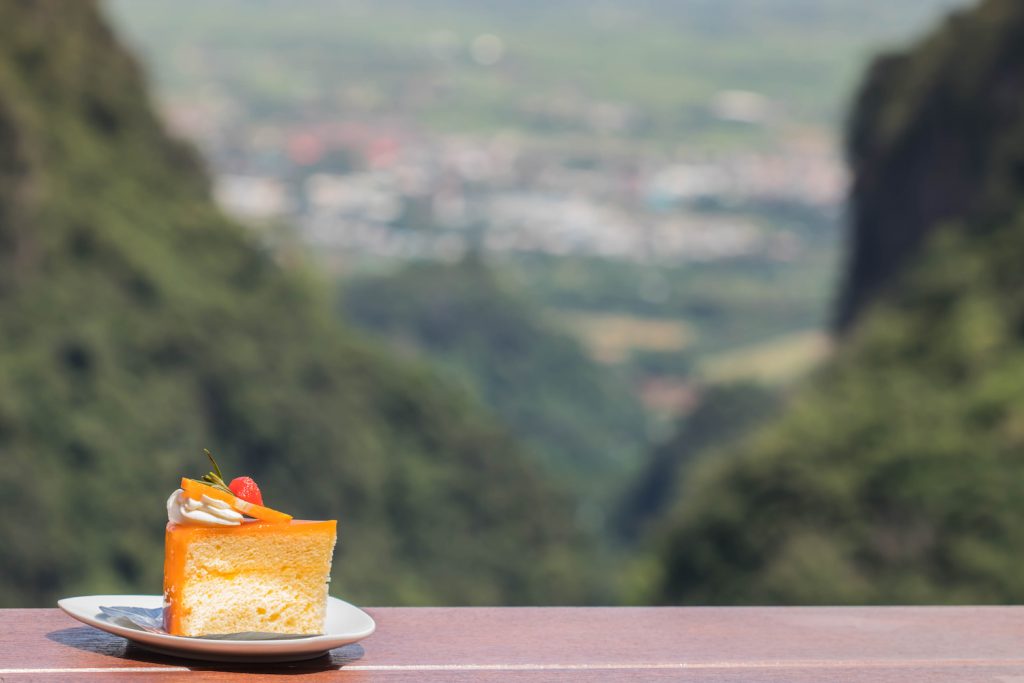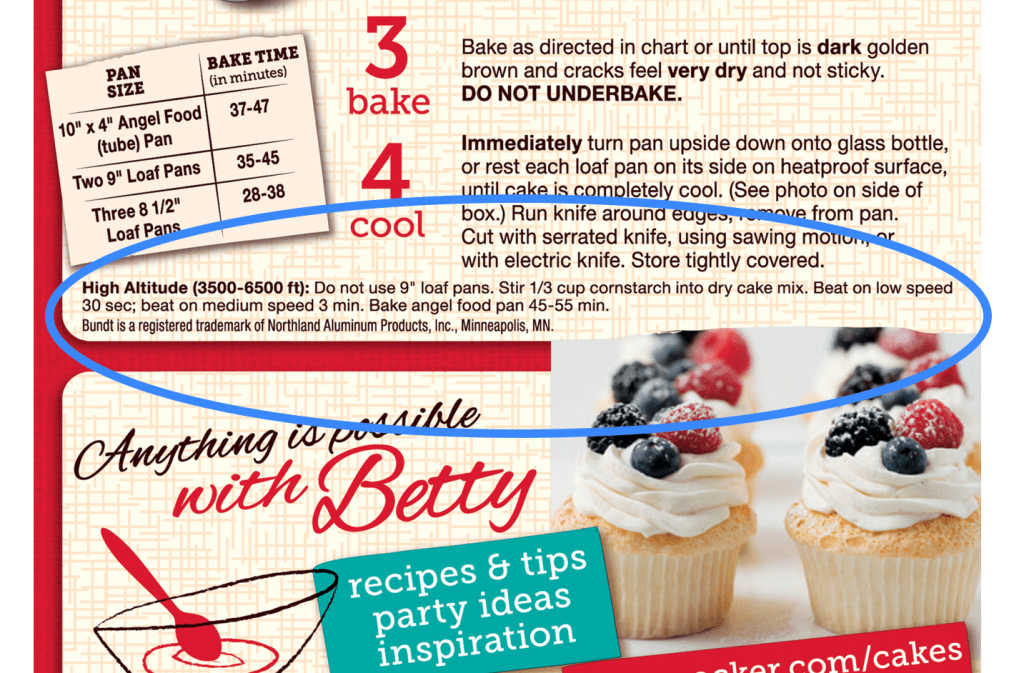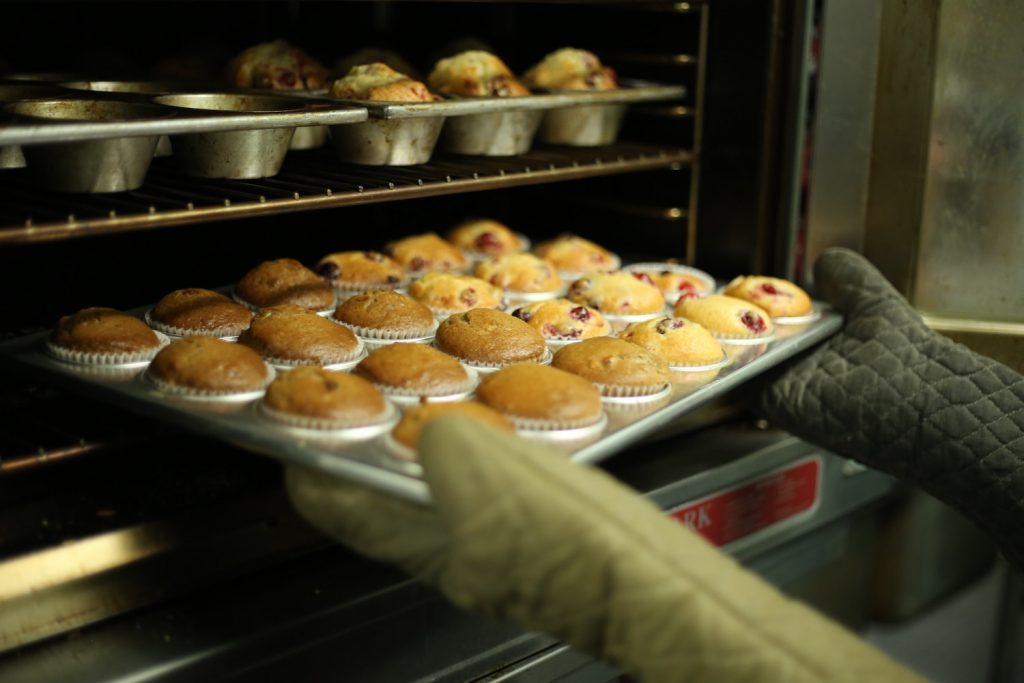
I grew up in Colorado, so I know a thing or two about high altitude.
Like how way too many out-of-staters are convinced that they can hike a mountain, and then almost pass out from altitude sickness. (Drink water and take it easy, out-of-staters!)
Like how I went back in Colorado from my now-home in Oregon and forgot that I was now used to low-altitude. Suddenly, I was the one who wasn’t able to keep up with my friends, the one who had to stop and take a lot of water breaks. (Such fun memories!)
But stupid tourists (and me!) aside, what does high altitude do to your baking?
If you’ve read enough recipes, you may have come across special instructions for high altitude. Some boxes of cake mix also include high altitude instructions on the back:

But why should it matter how high above sea level you are when you’re baking? Aren’t ingredients the same thing wherever you go?
Well, yes. Recipes need the same basic ingredients, no matter where you go. But the way ingredients react with one another can be different depending on altitude.
So it’s useful to understand the way ingredients react with each other, so you can fix any problems that arise!
So what are these high altitude effects?
The biggest change is air pressure. The higher up you go, the thinner the air is. That’s why it’s harder to breathe and move on the top of a mountain than it is at a beach.
Low air pressure can unfortunately cause your baked goods to rise too fast and then fall while in the oven, leaving you with sunken or dense cakes.
As well, water boils at a lower temperature at high altitudes. This means that any moisture in your baked goods will evaporate more quickly, and your bakes may turn out too dry.
What counts as “high altitude”?
Generally, “high altitude” is anywhere that’s 3000 feet or more above sea level. This is the level officially defined by the USDA. However, bakers at 2000 feet, or even 1000 feet, might find that they need to modify their recipes a little to combat the effects of altitude.
You obviously don’t have to modify your recipes if nothing seems to go wrong for you!
But if you’re finding that your baked goods are consistently too dry, or that they’re always falling in the oven, you may want to try modifying your recipe just a little to see if you get better results.
So how do you fix these problems?
First: don’t panic!
Living in the mountains doesn’t mean you can’t bake just as well as someone living on the coast. It just means you have to bake differently and understand the science behind high altitude. And if something doesn’t turn out quite right, it might just be the fault of the altitude, not you!
Second: The most important thing is to only modify one thing at a time. There are a number of different ways to combat the effects of altitude, but you don’t want to overcompensate and change around five different ingredients. You might just end up having your finished product turn into a gloopy, messy science project.
It’s way more effective to make a recipe several times and tweak something different every time.
So what are the different things you can try modifying?

Increase Temperature and Decrease Baking Time
As I mentioned before, low air pressure can make your baked goods rise too fast and fall while in the oven.
To get around this, you can play around with increasing the temperature of your oven by about 20 degrees fahrenheit. As well, decrease the baking time just a bit, to make up for the change in temperature.
Decrease Baking Soda/Baking Powder
With lower air pressure, leavening agents like baking soda have less air resistance. This means they are more effective at higher altitudes… but that can cause your baked goods to fall in the oven.
You can get around this by decreasing the amount of leavening agent slightly. The specific amount you should decrease depends upon your altitude:
- 3000-5000 feet: for every 1 teaspoon needed, decrease 1/8 teaspoon
- 5000-7000 feet: for every 1 teaspoon needed, decrease 1/6 teaspoon
- 7000 feet+: for every 1 teaspoon needed, decrease 1/4 teaspoon
Increase Liquid
As mentioned before, water boils at a lower temperature at higher altitudes, and evaporates quicker from your baked goods. If your bakes frequently turn out too dry, try increasing the amount of liquid that you use.
Here are some general guidelines:
- 3000-5000 feet: for every 1 cup needed, add 1 to 2 tablespoons
- 5000-7000 feet: for every 1 cup needed, add 2 to 4 tablespoons
- 7000 feet+: for every 1 cup needed, add 3 to 4 tablespoons
Decrease Rising Time for Yeasted Breads
In higher altitudes, bread will rise faster – similar to how baking soda and powder are more powerful.
This is something to keep an eye on to make sure your bread doesn’t overprove. But if you know what to look for to tell when your bread is risen properly, it shouldn’t pose too much of a problem.
But if it’s a consistent problem, you can also decrease the amount of yeast used by 1/4 teaspoon.
So what types of bakes are affected the most and the least by altitude?
Cakes and cupcakes are definitely affected the most! They are very reliant on texture and rise. The more delicate the cake, the more likely it is to collapse or end up too dry. To achieve the perfect cake, you may have to do a bit of experimenting.
Muffins and quick breads aren’t affected as much as cakes are, since they have a naturally denser texture that doesn’t collapse as easily. Still, you may need to tweak a few things here and there.
Pie and tart crusts are generally not affected, although if you find that they’re turning out too crumbly, you may want to add a little bit of extra water.
Cookies are probably the least affected by altitude. They generally turn out well, and it’s likely you won’t have to do much modifying to your favorite cookie recipe.
As I mentioned previously, it’s super important to only modify one element at a time if you’re trying to solve an issue. Try one method that seems like it’d solve your problem, and then troubleshoot from the resulting product.
Happy high altitude baking!

Leave a Reply
You must be logged in to post a comment.